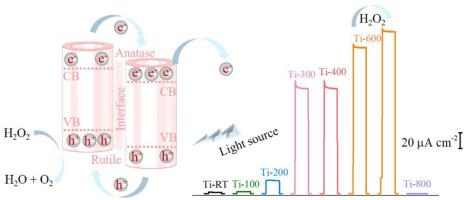无氟阳极氧化TiO2纳米管阵列用于光电化学H2O2传感:锐钛矿-金红石相变的作用
IF 6.3
2区 材料科学
Q2 CHEMISTRY, PHYSICAL
引用次数: 0
摘要
过氧化氢(H2O2)是一种普遍存在的活性氧(ROS),参与多种生理和病理过程。在肿瘤发展的不同阶段,肿瘤细胞和基质细胞中H2O2水平均有升高。因此,开发稳定、高效的H2O2检测方法具有重要意义。在这项研究中,一维(1D)有序TiO2纳米管通过电化学阳极氧化在无氟电解质中成功合成,随后在不同温度下退火,并证明了作为光电化学(PEC)催化剂在人血清样品中检测过氧化氢(H2O2)的潜力。采用场发射扫描电镜(FESEM)、透射电镜(TEM)、拉曼光谱(Raman spectroscopy)、x射线光电子能谱(XPS)、基于同步加速器的x射线吸收光谱(XAS)、广角x射线散射(WAXS)和x射线激发光学发光(XEOL)对1D TiO2纳米管的形貌和物理化学性质进行了系统表征。这些结果表明,热退火可以精确控制相组成(锐钛矿,金红石,或混合),以及Ti3+/Ti4+的分布和氧空位。优化后的纳米管具有定制的表面和结构特征,对H2O2传感表现出增强的PEC活性。所制备的TiO2纳米管阵列的线性检测范围为0 ~ 0.75 mM,灵敏度为14.98 μA mM - 1 cm-2,检测下限为131 μM,具有良好的选择性。此外,该传感器在人血清样品中表现有效,回收率为101.33%,相对标准偏差(RSD)为1.23%。这项研究强调了在无氟电解质中形成的阳极氧化1D TiO2纳米管作为一种环保方法的潜力,展示了对H2O2传感的显著(照片)电催化活性,并支持了它们在实际生物医学应用中的前景。本文章由计算机程序翻译,如有差异,请以英文原文为准。

Fluorine-free anodized TiO2 nanotube arrays for photoelectrochemical H2O2 sensing: Role of anatase-rutile phase transformation
Hydrogen peroxide (H2O2) is a ubiquitous reactive oxygen species (ROS) involved in diverse physiological and pathological processes. Elevated H2O2 levels are often present in both tumor and stromal cells during different stages of cancer progression. Therefore, developing stable and efficient methods for H2O2 detection is of great importance. In this study, one-dimensional (1D) ordered TiO2 nanotubes were successfully synthesized via electrochemical anodization in a fluoride-free electrolyte and subsequently annealed at various temperatures and demonstrated promising potential as photoelectrochemical (PEC) catalysts for hydrogen peroxide (H2O2) sensing in human serum samples. The morphology and physicochemical properties of the 1D TiO2 nanotubes were systematically characterized using field-emission scanning electron microscopy (FESEM), transmission electron microscopy (TEM), Raman spectroscopy, X-ray photoelectron spectroscopy (XPS), synchrotron-based X-ray absorption spectroscopy (XAS), wide-angle X-ray scattering (WAXS), and X-ray excited optical luminescence (XEOL). These results demonstrate that thermal annealing enables precise control over phase composition (anatase, rutile, or mixed), as well as the distribution of Ti3+/Ti4+ species and oxygen vacancies. The resulting optimized nanotubes, with tailored surface and structural features, show enhanced PEC activity toward H2O2 sensing. The developed TiO2 nanotube arrays displayed a linear detection range from 0 to 0.75 mM, a sensitivity of 14.98 μA mM–1 cm–2, and a low limit of detection of 131 μM, along with acceptable selectivity. Additionally, the sensor performed effectively in human serum samples, achieving a recovery of 101.33 % and a relative standard deviation (RSD) of 1.23 %. This study highlights the potential of anodized 1D TiO2 nanotubes formed in fluoride-free electrolytes as an environmentally friendly approach, demonstrating significant (photo)electrocatalytic activity for H2O2 sensing and supporting their promise for practical biomedical applications.
求助全文
通过发布文献求助,成功后即可免费获取论文全文。
去求助
来源期刊

Surfaces and Interfaces
Chemistry-General Chemistry
CiteScore
8.50
自引率
6.50%
发文量
753
审稿时长
35 days
期刊介绍:
The aim of the journal is to provide a respectful outlet for ''sound science'' papers in all research areas on surfaces and interfaces. We define sound science papers as papers that describe new and well-executed research, but that do not necessarily provide brand new insights or are merely a description of research results.
Surfaces and Interfaces publishes research papers in all fields of surface science which may not always find the right home on first submission to our Elsevier sister journals (Applied Surface, Surface and Coatings Technology, Thin Solid Films)
 求助内容:
求助内容: 应助结果提醒方式:
应助结果提醒方式:


